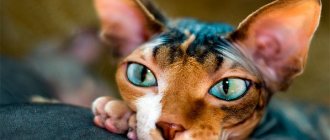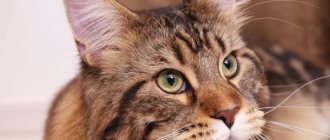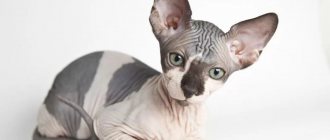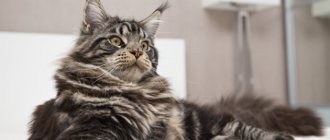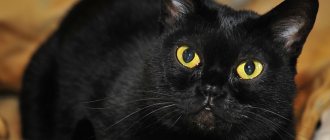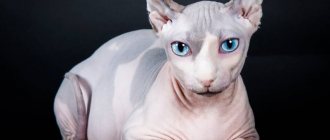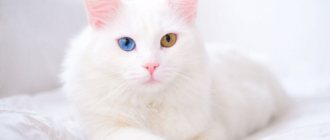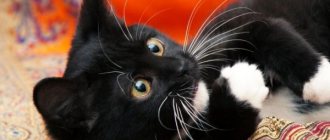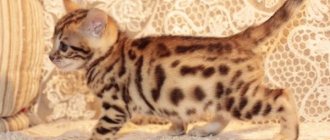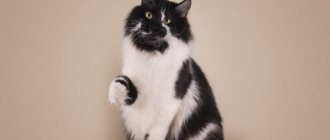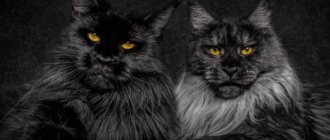A special variety of this cat breed is considered to be the Sphynx with fur, also known as the Don cat. The unusual appearance of the animal causes surprised looks from people, but after contact with it, the cat becomes a favorite. After all, these animals are very gentle, friendly, affectionate creatures. They do not cause allergic reactions, so they will become true friends for people suffering from allergies.
Types of sphinxes
Sphynx cats were bred in 1966 in Canada. This breed traces its origins to a kitten that was born completely hairless. During the selection process, a mutation was fixed that leads to the absence of hair. This is how the breed was developed - the Canadian Sphynx. It has existed for more than 50 years and is recognized by all felinological organizations.
About 25 years ago the following breeds were developed in Russia:
- Don Sphynx;
- Peterbald (Petersburg Sphynx).
These animal species are recognized by the World Cat Federation. Currently, these breeds are in the process of formation.
There are the following types of Sphynx coats:
- naked;
- flock;
- velours;
- brush;
- straight-haired.
Hairless cats are considered the most valuable for breeding. They have no fur at all, and their skin is soft and warm to the touch. Such animals are called “plasticine” or “rubber”. They have quite large body sizes. Hairless Sphynx kittens are usually born hairless.
The Don and Peterbald breeds have all of the above types of hair. They can be either bald or have barely noticeable fur.
Canadian Sphynx cats are carriers of the baldness gene. However, this type of cat is never completely naked. They always have a little hair.
Character
These cats are very curious and playful, they love to communicate, love to be looked at and played with. They quickly adapt to a new home and can easily cope with moving. They trust people, become very attached to their owner, and are loyal to him, like dogs. They accompany “their” person everywhere and do not leave him a single step. It is important for them to sleep on their owner’s lap or next to them in order to feel protected and loved.
Kids of this breed are extremely energetic, they are friendly and joyful, they often play pranks, chase each other, swing on curtains and adore their pets like their parents.
Cats often get cold both at home and outside, so they often sleep under a blanket. In winter they sit near the radiators, and in summer they bask in the sun. It happens that they even get a sunburn, their skin begins to peel off and come off in flakes.
Adult creatures are calm, love to sit on the windowsill and look at birds and passers-by. They get along well with children and other animals. It is better not to leave them alone for a long time; this can make the creature’s character aggressive, because it yearns for loneliness. Therefore, it is better to choose a different type if you are at work for a long time and there is no one at home. Another option is to get two cats, then they won’t get bored. They quickly get used to the tray, are clean and tidy.
Sphinxes are easy to offend, so you should treat them delicately, it’s better not to even raise your voice, because after screaming, your pet can sit in the corner for hours and remember the offense. He listens to his owner, follows his commands and tries to please him with his behavior.
He is calm and devoid of aggression, loves children and does not misbehave. He loves to play with children, allows himself to be dressed, wrapped in blankets, and painted. Will never scratch or bite. The Sphinx eats funny, he takes the tasty treat with his paw and puts it in his mouth, and opens his mouth to its full width over the bowl.
pros
Many owners note the friendly and easy-going nature of Sphynx cats with fur. Cats of this breed have the following advantages:
- lack of aggression;
- high intelligence;
- learning ability;
- good harmony with other species of animals;
- pickiness in food;
- cleanliness.
In addition, Sphynx cats with fur are considered healing cats. They have increased heat exchange, and the surface of the hair always remains hot. These animals can be used as living heating pads. They are extremely affectionate and love to cuddle up to the human body.
Advantages and disadvantages of plush sphinxes
Adult Don Sphynxes reach 30 centimeters at the withers, males look larger, and their weight ranges from 6 to 7 kilograms, while females weigh no more than 5 kilos. With proper care, representatives of the Brush breed live 14–17 years.
Interesting! The Sphynx Brush's body temperature fluctuates between 38-39 degrees, so when you touch your pet's skin it feels hot.
Advantages of the little hairy dog of this breed:
- friendly attitude towards children, lack of aggression towards other people;
- high intelligence, ability to train;
- easy contact with other animals;
- cleanliness;
- long lifespan, provided proper maintenance;
- absence of fleas and hair around the house.
A hairy pet also has a number of disadvantages:
- the need for regular skin care;
- the importance of maintaining the correct microclimate in a living space;
- increased susceptibility to dermatological type pathologies;
- specific body odor;
- insatiable appetite, increasing the risk of obesity.
Possible diseases
Sphynx Brush cats have a genetic predisposition to the following pathologies:
- eczema;
- entropion of the eyelid or underdeveloped eyeball;
- dermatitis;
- conjunctivitis;
- shortened lower jaw.
Minuses
Many people consider Sphynx cats to be hypoallergenic cats. However, hairy breeds can cause allergies. Especially often a negative reaction occurs after contact with Canadian and Don Sphynx cats with fur. Cats of this breed sweat a lot and need frequent bathing. Their skin produces a protein that can trigger allergies in humans.
Hairless sphinxes are not characterized by feline independence. These animals love to be constantly close to their owner. However, cats with fur are more self-sufficient. They are not always willing to sit in your arms and allow themselves to be petted.
Sphynx cats with fur can be lazy. They are less active and playful than their hairless relatives. These cats are often quite touchy. You cannot be too strict with them. Otherwise, the plush Sphynx may refuse to eat for a long time and even get sick.
Content
Sphynxes need sunbathing, after which the skin acquires a rich shade. But direct exposure to the sun's rays has a negative impact on health, and the cat can get burned.
Such hairy animals require careful care. It is important to regularly wipe the corners of your eyes to remove accumulated dirt and mucus. This can be done with a soft cloth soaked in warm water or with cotton pads in the direction from the edge to the center. The fluffy Sphynx tends to sweat, for this reason it is recommended for them to bathe with a mild, specialized shampoo. After taking water procedures, it is imperative to wipe the animal with a warm terry towel until completely dry. If the dirt on the cat's skin is small, you can wipe the area with wet wipes for animals that do not contain alcohol.
Particular attention should be paid to cleaning the ears of wax; in these animals it accumulates in large quantities. You can clean your ears using cotton swabs moistened with water or a special product. Sphynxes prefer to eat natural food, but you can also feed them premium and superpremium ready-made factory food.
Flock
Newborn kittens may appear hairless. But upon closer examination, you can notice sparse hairs no more than 2 mm long on the skin. The Sphynx flock has wool that resembles velvet in its structure. It covers the entire body of the animal.
The short coat persists only in childhood and young adulthood. As the animal grows, the hairs gradually become thinner and then disappear altogether. By about 2 years of age, cats become completely hairless.
Health and breed diseases
Today's sphinxes have good immunity. Anyone can get sick, but in order to avoid suffering for the pet and wasting the owner’s nerves, vaccination should be carried out in a timely manner. According to the vaccination calendar, the first one is given at 8 months of age, then at a year and beyond.
The most common diseases of sphinxes are:
- Turning of the eyelids (entropion). It occurs quite often and does not occur in the mildest form. If you notice watery eyes, do not self-medicate and consult a specialist. This disease can lead to vision loss.
- Skin diseases. Due to the lack of fur, this breed is prone to dermatitis and acne.
- Gastrointestinal diseases and obesity. These problems can arise due to improper nutrition or overfeeding of the animal.
- Ear mite. Check your pet's ears periodically and notice if he scratches them excessively.
- Lichen. This disease is a common problem in hairless cats. Monitor the condition of your skin and if any foreign spots appear, consult a doctor.
Velours
Velor cats have longer and fuller coats than flocked cats. The Velor Sphynx is born with velvet hair that is clearly visible to the touch. The length of the villi can reach up to 3 mm. Velor Peterbalds have longer hair on their paws, face and tail than on other parts of the body.
With age, hair follicles die off. Velor Don Sphynxes completely lose their hair. In adulthood, these cats appear completely hairless. Adult Peterbalds may still have remnants of hair on their paws and head.
What does the Don Sphynx look like?
After looking at the photo of the Don Sphynx, one gets the impression that he has a lot in common with Egyptian cats. The size of representatives of this breed reaches 25-30 cm in height at the withers. How much a Donchak should weigh depends on gender - boys are always larger. They reach 5-7 kg. The weight of girls is more modest and amounts to 3.5-5 kg.
Muzzle
The breed is characterized by a wedge-shaped head with pronounced cheekbones and a strong-willed chin. On the rounded muzzle there is a straight nose, connected to the wrinkled forehead by a pronounced stop. On the top of the head are large, widely set ears, rounded at the tips.
The Donchak has slightly slanted, almond-shaped eyes that lack eyelashes. Short vibrissae are twisted into a spiral. They often break off, and sometimes they don’t grow back at all. Defects of the breed include a narrow or rounded head, too small ears, inversion of the eyelids and an underbite of more than 2 mm.
Body type
The low and thin neck goes into a dense and muscular body, expanding in the croup and chest. The front limbs of the Doncha are shorter than the hind limbs. They end in strong and powerful paws with elongated toes. The flexible, whip-like tail tapers to a tip. An abundance of folds is characteristic of the neck, armpits, paws, abdomen, groin area and tail.
Skin and color
The elastic skin of the Don people is completely bald or covered with soft down. Depending on the type and structure of the existing fur, there are 4 varieties of the Don Sphynx:
- Brush
. The most unusual species with sparse curly fur. The length of its hairs is the maximum. Such animals are not allowed for exhibitions, but are used for breeding. With age, the number of curly hairs decreases.
- Flock
. The body is covered with “peach fuzz”, which gradually disappears.
- Velours
. Unlike flocks, the fluff of a velor cat is longer and thicker. It also disappears as they grow older, but sometimes the coarsest hairs remain on the head and paws.
- Hollowborn
. The fur is completely absent. The skin is covered with many wrinkles and is slightly sticky to the touch due to a special secretion. It is secreted by the sebaceous glands to protect against infections.
Among the colors of the Don Sphynx, any colors are allowed except lilac and chocolate. Due to the lack of fur, these cats rarely cause allergies in people.
Brush
The name of this breed comes from the English word “brash”, which means “brush”. The coat of such cats is hard, dense and curly. It resembles the sparse bristles of an old brush.
Brush kittens are born fully or partially covered with hair. There may be areas without hair on the neck and head. Over time, the fur often falls out, but may remain permanently. Sphynx brush baldness can be affected by weather conditions, vaccinations and hormonal changes. This breed is also distinguished by its curly whiskers (whiskers).
This type of cat is rarely allowed to participate in exhibitions. However, Brush Sphynxes are often purchased for breeding. They are crossed with completely hairless cats. At the same time, hairless kittens are born. Two hairless animals cannot be crossed, as they may produce non-viable offspring. The dominant gene that causes baldness is very susceptible to mutation.
Peterbalds have a brush-point coat. Kittens have longer hair on their face, paws and tail. These areas of the body are called points. The fur in these areas persists into adulthood. The remaining parts of the body become bare as cats grow older or become covered with flock pile.
Breeding
To breed Sphynx Brushes, the animal should be purchased from a professional, registered breeder. The most expensive are the naked ones, the sphinx velor is cheaper, while the brushes themselves are of average cost. The cost is affected by the gender and color of the animal. It may be difficult to find a partner, since in Russia this breed is not considered the most popular.
How to choose a kitten
You need to choose a kitten based on its health, knowing its pedigree. The kitten must have documents indicating its parents and grandparents. The kitten itself should be playful, active, and moderately inquisitive. There should be no discharge from the eyes and ears; this may indicate possible health problems. The animal must have all the required vaccinations and a veterinary passport with vaccination marks.
Choosing a name
It is necessary to choose a name based on the individual characteristics of a particular animal. This could be his character, origin story, interesting facts related to him.
Straight-haired cats
Straight-haired Sphynx cats are covered with regular hair. They have straight mustaches. With age, the hair does not fall off; the fur remains forever.
Straight-haired cats are obtained by crossing Sphynxes with Siamese and Oriental breeds. They lack the hairless gene. Despite the presence of hair, straight-haired animals are classified as sphinxes. Their appearance, character and habits are characteristic of this breed of cats. The hair on the body is considered a heritage of Oriental cats.
Straight-haired animals are mainly found among Peterbalds, less often among Don Sphynxes. Sometimes kittens with fur are born to completely hairless individuals. This is due to failures in genetics.
This type of sphinx cannot take part in exhibitions. Straight-haired kittens are discarded from breeding. The presence of permanent hair is considered a deviation from breed standards.
Why does the Sphynx begin to grow hair?
Kittens and adult Sphynx cats sometimes begin to grow hair. There may be several reasons.
- Cold weather.
With the onset of cold weather, most sphinxes are covered with short fluff; in some areas of the body the hair can be quite long. It can grow back even if it only got cold outside the window, but the temperature in the house was always maintained at a comfortable level. - Heredity.
Canadian Sphynxes are the most stable breed. The appearance of fur on them usually indicates the “sins” of the breeder and accidental interbreed matings. You can expect everything from Donetsk, Peterbald, Levkoy and other hairless breeds. They are on the path of becoming. It happens that kittens do not shed their fur and this cannot be predicted, and adult cats can grow and remain fluffy. - Hormonal changes.
Wool can grow rapidly or, on the contrary, fall out as a result of puberty, pregnancy, castration/sterilization, disruption of the endocrine system and other factors affecting the general hormonal balance.
Observations show that reasons such as feeding, illness, stress in combination with the above can affect the amount of hair in a hairless cat.
Regardless of the amount and length of the sphinx's fur, the character and habits usually do not change. Even in their fluffy form, they remain very gentle and sociable creatures who adore warmth and comfort.
Canadian Sphynx
This cat breed is never completely naked. Sphynx kittens are not born hairless. Their hairline resembles suede. In adulthood, hair remains on the nose, behind the ears, as well as on the paws and tail. It looks like thin twisted fibers. The Canadian Sphynxes have all of the above varieties of coat.
Rules of care
These cats do not need serious care:
- Sphynx Brush cats are fed natural or premium dry food. Also, the cat’s body constantly needs a large amount of fluid and properly selected vitamins.
- Don't forget that the Sphynx Brush's ears and teeth need regular cleaning. Optimally - once a week.
- Brush cats need to be bathed regularly. You can buy a special product or take a good baby shampoo.
- Cats don't have eyelashes, so pay attention to their eyes. This is especially true for kittens - it is better to wipe their eyes with a damp, clean swab once a day.
Important! The hair of a plush Sphynx can change due to a new diet, temperature, humidity in the room, changes in hormonal levels during gestation or estrus.
conclusions
Is it worth buying a Sphynx kitten covered with fur? It depends on the purpose of purchasing the animal. If you are planning to take your pet to exhibitions, it is better to opt for hairless cat varieties. Animals with fur may not be allowed to exhibit. However, most hairy breeds (except straight-haired) can be bred for breeding and produce hairless offspring. In addition, Sphynx cats with fur can make wonderful pets. They are distinguished by their lack of aggression, goodwill and affection.
Source: fb.ru
Price
You should only buy a kitten from trusted breeders or nurseries; a sick or outbred animal may be slipped into the market.
It is necessary that the parents and the baby have documents; it is better to conclude an agreement with the seller. Pay attention to whether vaccinations have been completed and whether worm prevention has been carried out; do not take a four-legged animal under two months old.
He must be active, without external defects, and cheerful. The average price of such a kitten is ten to fifteen thousand rubles, but can reach up to twenty-five thousand. Always pay attention to the conditions in which the hairworm is kept. If the apartment is clean and tidy, and the baby’s parents look healthy and well-groomed, then most likely this is a bona fide breeder.
